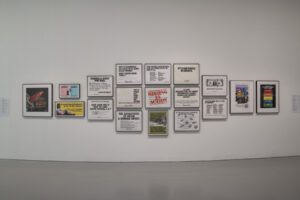
Gee whiz. There’s one manifesto that I’m a huge admirer of: Roxy Music’s album from 1979. An unenthused Greil Marcus found okay “moments” that are better than many records, but still found they “…add up to little” (he always liked Eno better.) I think it’s funky, sleek, listenable power pop. It has narrative peaks and valleys. Lovely formal dynamics, sonic invention, emotional bandwidth. It’s beautifully crafted. Brian Ferry is tragic and party-addled. But he studied art under Richard Hamilton (who was himself influenced by Wentworth-Thompson’s On Growth and Form), taught art and pottery while getting his rocknroll legs in the 1960s. He’s the son of a farm laborer. Romantic. Yep. Just listen to it. (Vinyl? CD? MP3?) Through your noise cancelling headset. Technology. Just has a mind of its own.
Just look at all the historical shit I tied together in one paragraph.
Look up the title lyrics yourself. I’d echo Marcus on the Hirshhorn’s exhibition. Manifesto: Art x Agency, talks a certain talk, (“moments”), but is so wanting of critical imagination that it bizarrely fails to identity itself with an American political moment of renewed democratic agency not lacking in political violence; a mainstream discussion of democratic socialism prompted by a long dawning train wreck of classical liberal-cum-progressivism and populist christo-fascist white supremacism; utterly comical villains U.S. Attorney General William Barr, President Trump, tiki torch toting KKK. Vice President Mike “Call me a cab, but don’t call me a queen” Pence, thirsting like Jesus for the clean-up. The United States of America – the actualization of two very concrete and hallowed Enlightenment manifestos – stands upon an historical inflection point, but the exhibit takes little notice of America, the Enlightenment, those other manifestos just up the Mall. Insert ironic thoughtful emoji. Neither make an appearance, though it would be an obvious choice for a general public that wants relevance. At least a nod? Ah, never mind. There’s no fucking connection I guess.
No particular notice is taken of the intrinsic back to the future nature of the show, the fact that we are living the future imagined by some of the artists. The curation takes no objective notice of the degree of institutionalization of art today, and how that dramatically shapes our historical relationship with the question of manifestos and artists’ agency, our human self-awareness as makers. The film portion makes it fun (in a fun house way), but the show fails to rise above a middle schooler’s sense of an obligatory inventory. There is a public interest to which chief curator Stephane Aquin should attend. Is this really the measure of the autonomy of a government-owned art space in 2019?
An exhibit in three parts, the first section dutifully ticks off Futurism, Dada, Surrealism, Abstract Expressionism, etc – the usual suspects of modern art. The final third of the exhibit (it is split more or less into thirds) is a selection of more recent activist postmoderns ranging from Adrian Piper to Zoe Leonard. While this section is titled “A Renewed Sense of Agency”, no manifestos unite these artists. Maybe the Bill of Rights? What are the implications? De minimus the curation might have touched upon the Frankfurt School of critical theory, so central to post modern social critique in art practice. Again, barely perfunctory.
Julian Rosefeldt’s Manifesto film installation occupies the second section with sound and opulence that sensually beggars the other galleries. Manifesto is here presented roughly in 13 manifestos, 13 channels on 13 screens simultaneously. It reads and sounds quite differently as an installation than the film. It’s clearly the center piece.
Cinema gloats. Start with a burning fuse and a mashup of Marx, Engels, and Tristan Tzara. Sexy. The sequence proceeds to Futurism juxtaposed with the Situationists of the 1970s; mutually opposed movements (ideologically and scenically). As chapters first and second, there is a mute commentary and the palest suggestion that perhaps one or any of the artist manifestos could be comparable somehow to the Communist Manifesto. For the most part they are yawps. Not formal treatises.
The combined noise of soundtracks unfortunately results in a rather nihilistic jumble, probably not predicted either by the artist or the Hirshhorn’s chief curator. Along this line, there is much in the exhibit that supports Marcuse’s view that transgression has been fully subsumed by capitalism and that we live today in a thoroughly imagination–killing, capitalist totalitarian prison.
Little comparison is made between those manifestos that have explicit political ends and those that focus on formal esthetics. What then do these exhortations have to do with our humanity or with the project of Enlightenment Humanism? There is simply no contextualization, resulting, if one doesn’t know better, in a poignant quaintness that slips into dubious irrelevance.

America, indeed the promise of western democracy, is in a pregnant historical moment, with resurgent nationalist and militarist influences mutilating basic social and cultural institutions. But we are never reminded that we are living in the futures imagined by these artists, and that there are still things that can and must be imagined. You might conclude that as much as an homage to “art and agency,” this was also a eulogy.
Todd Parola
Volume 34 no 3 January – February 2020 pp 28-29
Manifesto: Art x Agency: The Hirshhorn Museum, Washington D.C., until April 6, 2020
